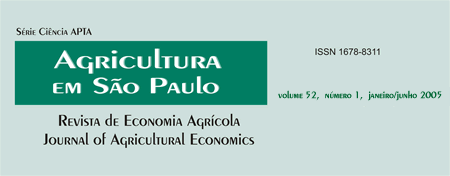
Ieda
Del´Arco Sanches
José
Carlos Neves Epiphanio
Antonio
Roberto Formaggio
O
sensoriamento remoto constitui-se em ferramenta de grande contribuição
para o
monitoramento
da atividade agrícola, e, desta forma, vem ganhando cada vez mais
espaço nessa área. Para potencializar ganhos de resultados
com o uso desta tecnologia, é necessário levantar o padrão
de uso do solo da região a ser estudada e conhecer a correlação
entre os variados alvos em imagens de satélite e no campo ao longo
do tempo. Este trabalho objetivou: verificar as variações
de comportamentos espectrais de cana-de-açúcar, soja e milho
em imagens de satélite, fazendo a correlação com verificações
de campo; desenvolver um melhor entendimento dos fatores que influenciam
as reflectâncias multiespectrais e multitemporais dessas culturas;
e estabelecer um padrão espectro-visual de culturas para a área
de estudo. Foi averiguado que a distinção das três
culturas, nas imagens Landsat, não foi possível na fase inicial
de crescimento dessas plantas. Entretanto, a soja em pleno desenvolvimento
foi facilmente separada da cana-de-açúcar e do milho, o que
é de grande significado para as estatísticas agrícolas
com imagens de sensoriamento remoto.
Palavras-chave: análise multitemporal, sensoriamento remoto, cana-de-açúcar, soja, milho.
Remote
sensing brings a significantly effective contribution to agricultural
monitoring,
with a growing potential for its use. For further gains in results to be
achieved, it
is
important to survey the land use pattern in the region of interest and
to correlate the behavior of the studied crops (field x image) over time.
The objective of the present work was threefold: (a) to verify the changes
in the spectro-temporal behavior of sugarcane, soybean and corn crops in
Landsat ETM+ imagery, making correlation with the field conditions; (b)
to build a better knowledge about the factors that affect the reflectance
of those crops; and (c) to establish a crop spectral pattern for the area
studied. It was verified that in the beginning of the growing season sugarcane,
soybean and corn crops were not spectrally distinguishable. Nevertheless,
when the phenological phase is at the maximum vigor, soybean presented
a particular spectral response that made it possible its discrimination
from sugarcane and corn, which is very significant to agricultural remote
sensing.
Key-words: multitemporal analysis, remote sensing, sugarcane, soybean, corn.
JEL Classification: O13, Q16, R14.